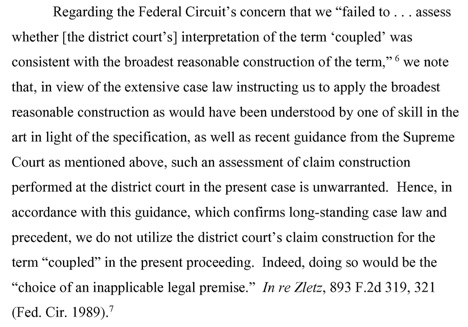The Federal Circuit got a little taste of patent prosecution in deciding the recent case of In re Power Integrations. The patent at issue had undergone ex parte reexamination, been appealed to the Board, and then appealed to the Federal Circuit. In parallel litigation, the patent had also undergone claim construction by a district court judge. The claim construction conducted by the Board under BRI differed from that of the district court judge who construed the claim under the Phillips standard used for patent litigation.
In the Federal Circuit’s first appeal decision, the Federal Circuit remanded the case back to the Board so that the Board could take into consideration the analysis performed by the district court judge. The court said, in part:
We do not hold that the board must in all cases assess a previous judicial interpretation of a disputed claim term. Nor do we express any view on the merits of Power Integrations’ proposed construction of the term “coupled to.” We hold only that the board on remand should carefully and fully assess whether the disputed claims of the ‘876 patent are anticipated by the prior art, setting out its reasoning in sufficient detail to permit meaningful appellate review. See Lee, 277 F.3d at 1346 (emphasizing that remand is required where a board decision “is potentially lawful but insufficiently or inappropriately explained” (citations and internal quotation marks omitted)); see also Nazomi Commc’ns, Inc. v. Arm Holdings, PLC, 403 F.3d 1364, 1371 (Fed.Cir.2005) (vacating and remanding a district court’s claim construction determination because the court did “not supply the basis for its reasoning sufficient for a meaningful review”).
|
Power Integrations, Inc. v. Lee, 797 F.3d 1318, 1327 (Fed. Cir. 2015).
|
The Board, however, declined to take into consideration the district court’s claim construction. The Board wrote in its second opinion:
When the second Board opinion was appealed to the Federal Circuit, the court did not seem too pleased with the “unwarranted” language. Judge Moore, for example, commented:
It is interesting that the Solicitor’s Office did not address Judge Moore’s question of whether there is someone who reviews Board opinions after they are drafted by the Board panel members. It has been a mystery to the patent bar how the Board operates internally. Shrouded silence only fosters rumor and speculation. It would be useful if the Federal Circuit panels would press the Solicitor’s Office for more detail during oral argument about how the Board operates internally. Presumably, every Federal Circuit panel wants to make sure it has jurisdiction before deciding a case. And, the Federal Circuit does not have jurisdiction to decide a case that has been decided not in accordance with the statutes and regulations governing the operation of the Board, i.e., illegally.
You can listen to the entire oral argument here:
You can read the court’s opinion [here].
